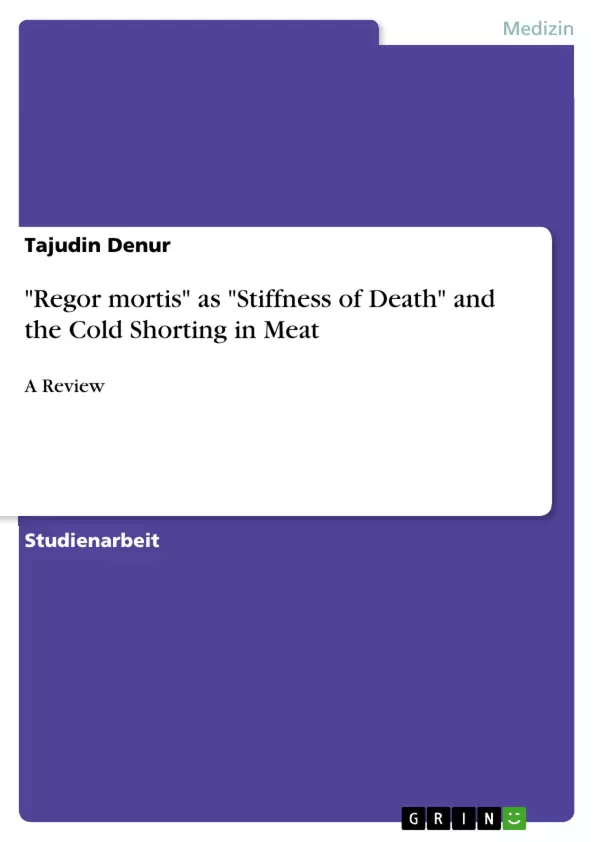Rigor mortis is Latin for "stiffness of death". It is used medically to describe the stiffness of skeletal muscles that appears soon after death. Fully developed rigor mortis in muscle is characterized by maximum loss of extensibility. Regor mortis can be classified in to three phases, the first phase, when a well-marked rigidity was established in the muscles, the second phase, when the complete rigidity was established and the third phase, where the rigor begin to pass off. Cold-shortening occurs when muscles are exposed to low temperatures (below 10 °C to 15 °C) early post mortem, when ATP and pH levels are still high (pH above 6.2). On the other hand, rigor tension occurs much later and at any temperature between 0 ºC and 37 ºC, reaching maximum values when ATP levels have been depleted and pH is at a minimum value. Cold shortening decreases tenderness which is due to muscle fiber contractions that occur before the onset of rigor. Different carcasses in the same chiller can undergo cold shortening that deteriorate the tenderness of meat. Toughening due to cold shortening cannot be eliminated by aging of meat. A thumb rule to avoid cold shortening is that the temperature of the muscle should be kept high i-e above 10ºC till the pH of meat which is initially 7.0-7.2 at the time of death falls below 6.0.
Inhaltsverzeichnis
- Executive Summary
- 1. Introduction
- 2. Literatur Review
- 2.1. Rigor Mortis In Meat
- 2.1.1. Delay Period
- 2.1.2. Onset of Rigor
- 2.1.3. Rigor (Irreversible phase)
- 2.1.4. Resolution of Rigor Mortis
- 2.2. Effects of Rigor Mortis on Appearance
- 2.3. Effects of Thaw Rigor on Tenderness
- 2.4. Cold Shortening In Meat
- 2.4.1. Effects of cold shortening on tenderness
- 2.1. Rigor Mortis In Meat
- 3. References
Zielsetzung und Themenschwerpunkte
Diese Arbeit befasst sich mit der Untersuchung von Rigor Mortis und Kältekürzung im Fleisch. Ziel ist es, einen Überblick über die Prozesse, ihre Auswirkungen auf die Fleischqualität (insbesondere die Zartheit) und Möglichkeiten der Vermeidung negativer Effekte zu geben.
- Rigor Mortis: Phasen, Mechanismen und Auswirkungen auf die Fleischbeschaffenheit
- Kältekürzung: Ursachen, Bedingungen und Einfluss auf die Zartheit
- Zusammenhang zwischen ATP-Spiegel, pH-Wert und Muskelverkürzung
- Methoden zur Vermeidung von Kältekürzung
- Auswirkungen der Fleischtemperatur auf die Entwicklung von Rigor Mortis und Kältekürzung
Zusammenfassung der Kapitel
1. Introduction: Die Einleitung beschreibt den metabolischen Umstellungsprozess im Muskel nach der Schlachtung, den Übergang von aerobem zu anaerobem Stoffwechsel und die damit verbundene Laktatansammlung, die den pH-Wert senkt. Sie führt den Begriff Rigor Mortis ein und erklärt dessen Entstehung durch den Verbrauch von ATP und die irreversible Bindung von Aktin und Myosin. Die Einleitung betont die Bedeutung von ATP-Verfügbarkeit und Temperatur für die Muskelkontraktion und die Entstehung von Kältekürzung.
2. Literatur Review: Dieses Kapitel bietet eine umfassende Übersicht über den wissenschaftlichen Kenntnisstand zu Rigor Mortis und Kältekürzung. Es gliedert Rigor Mortis in verschiedene Phasen (Verzögerungsphase, Beginn, irreversible Phase, Auflösung) und analysiert detailliert die Auswirkungen auf die Fleischbeschaffenheit, insbesondere die Zartheit. Der Einfluss von Temperatur auf die Entwicklung von Rigor Mortis und Kältekürzung wird eingehend behandelt, ebenso wie Strategien zur Minimierung der negativen Auswirkungen von Kältekürzung auf die Fleischqualität. Der Abschnitt über Kältekürzung betont die Bedeutung von Temperaturkontrolle im postmortalen Zeitraum für die Erhaltung der Fleischzartheit. Die Zusammenhänge zwischen ATP-Verfügbarkeit, pH-Wert und Muskelverkürzung werden im Detail erläutert, und es wird gezeigt, wie diese Faktoren die Fleischqualität beeinflussen können.
Schlüsselwörter
Rigor Mortis, Kältekürzung, Fleisch, Zartheit, ATP, pH-Wert, Muskelverkürzung, postmortaler Stoffwechsel, Temperatur, Fleischqualität
Häufig gestellte Fragen (FAQ) zu: Untersuchung von Rigor Mortis und Kältekürzung im Fleisch
Was ist der Gegenstand dieser Arbeit?
Diese Arbeit untersucht die Prozesse von Rigor Mortis und Kältekürzung im Fleisch, ihre Auswirkungen auf die Fleischqualität (insbesondere die Zartheit) und Möglichkeiten zur Vermeidung negativer Effekte. Sie bietet einen umfassenden Überblick über den aktuellen wissenschaftlichen Kenntnisstand.
Welche Themen werden behandelt?
Die Arbeit behandelt folgende Themenschwerpunkte: die Phasen von Rigor Mortis und deren Mechanismen, die Auswirkungen auf die Fleischbeschaffenheit, die Ursachen und Bedingungen von Kältekürzung und deren Einfluss auf die Zartheit, den Zusammenhang zwischen ATP-Spiegel, pH-Wert und Muskelverkürzung, Methoden zur Vermeidung von Kältekürzung und die Auswirkungen der Fleischtemperatur auf die Entwicklung von Rigor Mortis und Kältekürzung.
Wie ist die Arbeit strukturiert?
Die Arbeit beinhaltet eine Einleitung, einen Literaturüberblick, und ein Kapitel mit Referenzen. Die Einleitung beschreibt den metabolischen Umstellungsprozess im Muskel nach der Schlachtung und die Entstehung von Rigor Mortis. Der Literaturüberblick bietet eine detaillierte Analyse von Rigor Mortis (Verzögerungsphase, Beginn, irreversible Phase, Auflösung) und Kältekürzung, einschließlich der Auswirkungen auf die Fleischzartheit und Strategien zur Minimierung negativer Effekte. Die Arbeit enthält auch ein Inhaltsverzeichnis und eine Zusammenfassung der Kapitel sowie Schlüsselwörter.
Was ist Rigor Mortis und wie wirkt es sich auf das Fleisch aus?
Rigor Mortis ist der Prozess der Totenstarre. Die Arbeit beschreibt die verschiedenen Phasen (Verzögerung, Beginn, irreversible Phase, Auflösung) und erklärt, wie der Verbrauch von ATP und die irreversible Bindung von Aktin und Myosin zur Muskelversteifung führen. Die Auswirkungen auf die Fleischbeschaffenheit, insbesondere die Zartheit, werden detailliert analysiert.
Was ist Kältekürzung und wie kann man sie vermeiden?
Kältekürzung ist eine unerwünschte Muskelverkürzung, die durch niedrige Temperaturen im postmortalen Zeitraum verursacht wird. Die Arbeit erläutert die Ursachen und Bedingungen von Kältekürzung, ihren Einfluss auf die Fleischzartheit und Methoden zur Vermeidung. Die Bedeutung der Temperaturkontrolle wird hervorgehoben.
Welche Rolle spielen ATP und der pH-Wert?
Die Arbeit untersucht den Zusammenhang zwischen ATP-Spiegel, pH-Wert und Muskelverkürzung. Diese Faktoren beeinflussen die Fleischqualität maßgeblich, da sie die Entwicklung von Rigor Mortis und Kältekürzung beeinflussen.
Welche Schlüsselwörter beschreiben den Inhalt der Arbeit?
Die Schlüsselwörter sind: Rigor Mortis, Kältekürzung, Fleisch, Zartheit, ATP, pH-Wert, Muskelverkürzung, postmortaler Stoffwechsel, Temperatur, Fleischqualität.
- Quote paper
- Tajudin Denur (Author), 2020, "Regor mortis" as "Stiffness of Death" and the Cold Shorting in Meat, Munich, GRIN Verlag, https://www.grin.com/document/982807



